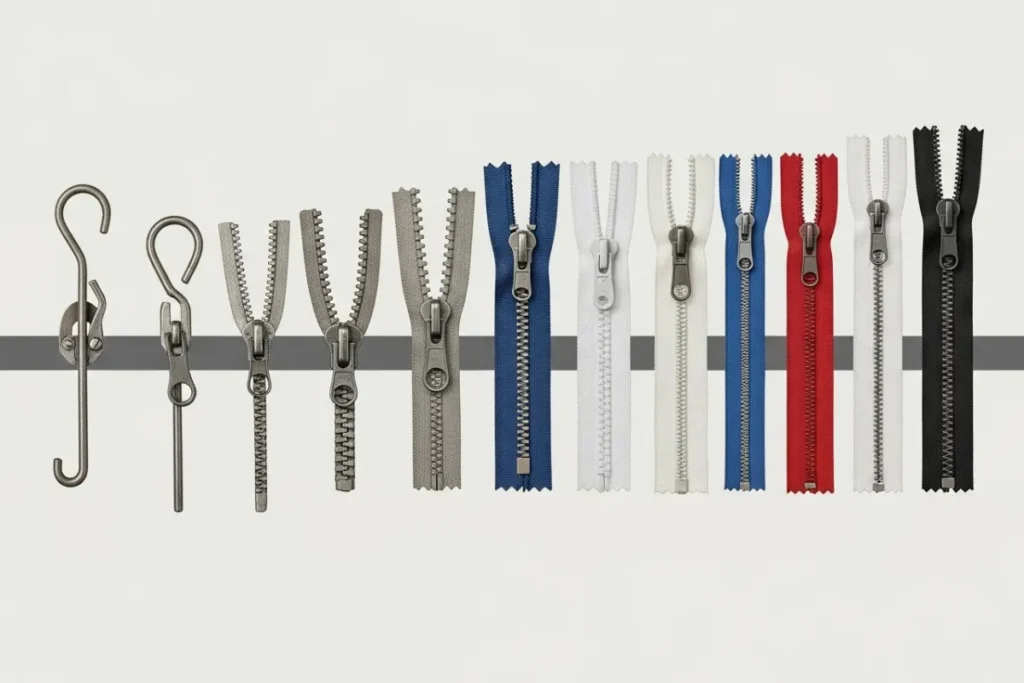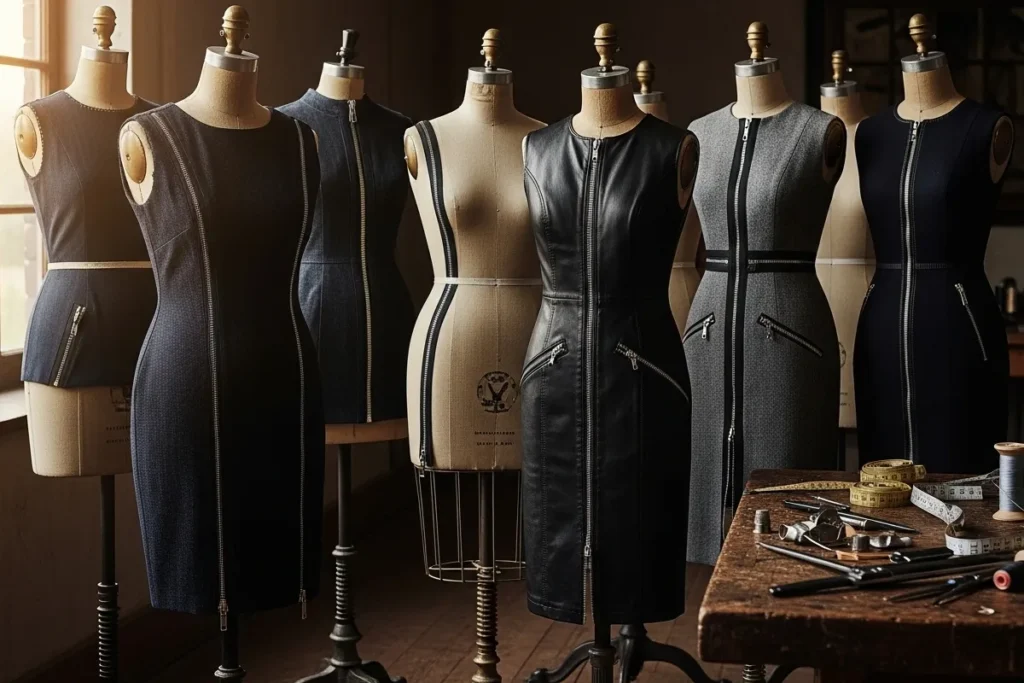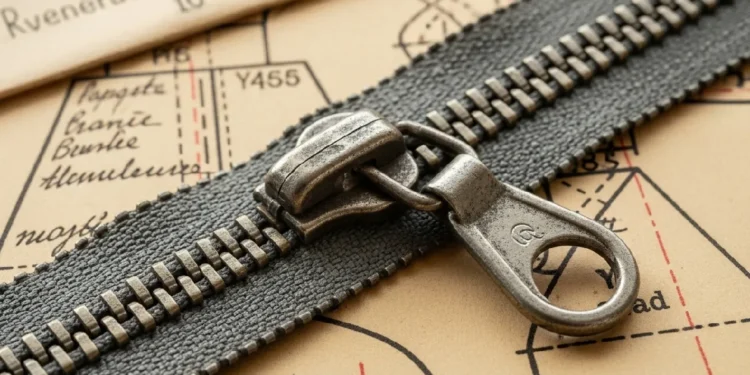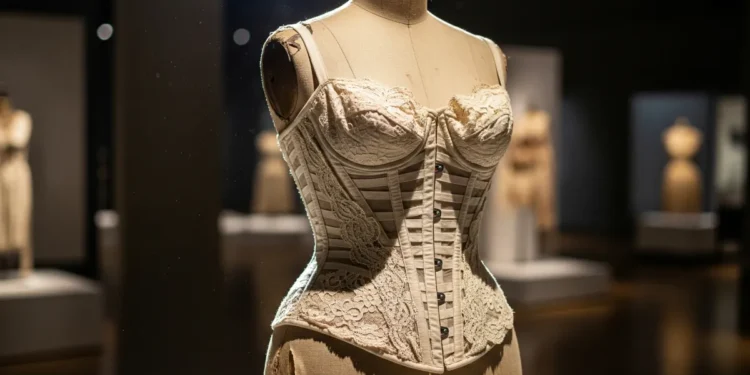An investigative cultural history of the zipper, showing how this fastener reshaped fashion, gender norms, labor practices, and bodily autonomy.
Table of Contents
Introduction
The history of the zipper is a story we think we know: a simple, linear tale of convenience. But that familiar metallic sound—the zip—is not just the sound of closure. It is the echo of a revolution that redefined our relationship with our clothing, our bodies, and even each other. This seemingly mundane object carries within its interlocking teeth a dramatic narrative of innovation, social strife, and aesthetic power. Rethinking the history of the zipper means looking beyond the seam to see how a simple fastener became a powerful engine of cultural change, for better and for worse.
Before the zipper, dressing was an act of dependence, a world constrained by intricate laces and endless rows of hooks and eyes. The invention promised liberation—a new speed and autonomy in the daily ritual of clothing. Yet, this promise was double-edged. As we will explore, the very technology that freed the body also helped to bind it to new, unforgiving standards of a perfectly smooth, contained form. The flawed history of the zipper is therefore a story of profound contradiction, a tale of a device that offered freedom with one hand while enforcing a new kind of discipline with the other.
This article will trace this complex journey, beginning in a world bound by hooks and eyes before exploring Gideon Sundback’s crucial invention and its legitimization by the military. We will examine its explosive entry into high fashion, where it became a focal point in the battle over gendered clothing, and then shift our focus to the factory floor to analyze its impact on labor and the rise of fast fashion. Finally, we will consider the zipper’s modern legacy and its future, revealing how the complete history of the zipper continues to quietly shape our world.
The Age of Hooks and Eyes: A World Before the Zip
Before the swift, satisfying pull of a zipper, the act of dressing was a far more complex affair, a daily ritual of meticulous fastening that speaks volumes about the societies that preceded ours. For centuries, garments were held together by a combination of buttons, laces, and, most notably, long, unforgiving rows of hooks and eyes. This was an era of sartorial dependence, where the wealthy often required physical assistance to navigate the intricate closures of their corsets and gowns.
This reality reinforced social hierarchies, creating a tangible barrier between those who could afford servants to dress them and those who could not. The inconvenience wasn’t just a matter of time; it was a physical manifestation of a rigid social fabric.
The initial chapters in the history of the zipper were marked by ambitious failure, reflecting a growing societal frustration with these antiquated methods. The industrial age was dawning, and with it came a demand for efficiency in every aspect of life, including clothing. The first attempt at a slide fastener came from Elias Howe, the inventor of the sewing machine, who patented an “Automatic, Continuous Clothing Closure” in 1851. However, his invention was impractical and never reached the market.
Decades later, in 1893, Whitcomb L. Judson debuted his “Clasp Locker,” but it was a clumsy, unreliable device prone to popping open. These early efforts represent the flawed history of the zipper, a period of noble intentions that failed to deliver a truly functional solution.
This persistent search for a better fastener was more than a mere quest for convenience; it was a direct response to the quickening pace of modern life. As urbanization and industrial labor reshaped daily routines, the cumbersome closures of the past became increasingly untenable. The world was beginning to move faster, and clothing needed to keep up. The stage was set for a technological revolution, a moment where the right invention could not only solve a practical problem but also unlock new possibilities for personal autonomy and style. The demand was clear, but the technology had yet to catch up, leaving a crucial gap in the narrative of the history of the zipper that was waiting to be filled.

Gideon Sundback and the Birth of the Modern Zipper
The history of the zipper truly began to take shape not with its initial conception, but with its perfection. The critical breakthrough came from Gideon Sundback, a Swedish-American electrical engineer who joined the Universal Fastener Company and dedicated himself to fixing the flawed designs of his predecessors. By 1913, he had completely redesigned the device, creating the “Hookless No. 2.” His genius lay in replacing the cumbersome hook-and-eye system with small, interlocking teeth that a single slider could seamlessly join and separate. This innovation provided the reliability and elegance the fastener had desperately lacked, transforming it from a clumsy gimmick into a viable, mass-producible technology.
Despite Sundback’s success, the fashion industry remained deeply skeptical. The zipper’s early life was decidedly unglamorous, confined to utilitarian items far from the world of haute couture. The B.F. Goodrich Company was one of the first major adopters, using the fastener on its rubber galoshes and coining the onomatopoeic name “zipper” in 1923. For years, its application was limited to everyday objects like money belts and tobacco pouches. This period of slow adoption reveals a fascinating resistance to change within the fashion establishment, a cautious phase in the history of the zipper where its revolutionary potential was yet to be fully embraced.
The zipper’s fortunes changed dramatically with the outbreak of World War I. The U.S. military, seeking efficiency and durability for its troops, adopted the fastener for uniforms and gear, including flying suits and money belts. This large-scale application under the rigorous conditions of warfare served as the ultimate field test, proving the zipper’s strength and practicality to a global audience. The military endorsement stripped the zipper of its novelty status and imbued it with a sense of masculine reliability and modern functionality, setting the stage for its eventual conquest of the civilian wardrobe and cementing its place in industrial history.
The Battle of the Fasteners: Zippers, Gender, and High Fashion
The zipper’s journey from military gear to high fashion was propelled by the audacious vision of couturiers who saw its disruptive potential. In the 1930s, Italian designer Elsa Schiaparelli was the first to elevate the zipper from a mere fastener to a deliberate, often provocative, design element. She placed zippers in unconventional places on her gowns, using their metallic teeth to create stark, decorative lines that were both functional and jarringly modern. This act transformed the zipper into a symbol of avant-garde chic, challenging the soft, traditional closures that had dominated wear. Schiaparelli’s embrace marked a pivotal moment in the history of the zipper, proving it could be an object of beauty and subversion.
Simultaneously, a fierce debate known as the “battle of the fly” was raging in menswear. In 1937, Esquire magazine championed the zippered fly as the epitome of modern masculinity, a sleek and efficient alternative to the cumbersome button fly. Yet, traditionalists recoiled, viewing the zipper as a threat to modesty and a lazy, almost vulgar, shortcut. The controversy deepened as women began to adopt trousers with zippered flies, an act that directly challenged established gender codes. The zipper became a focal point for anxieties about shifting social roles, representing a new, and for some, unsettling ease of access and bodily autonomy.
Beyond these cultural skirmishes, the zipper fundamentally altered the silhouette of modern clothing. Its ability to create a smooth, uninterrupted closure enabled the rise of form-fitting garments that clung to the body’s contours in a way that buttons and hooks never could. This innovation streamlined fashion, introducing a new aesthetic of speed and seamlessness that perfectly captured the spirit of the machine age. The zipper didn’t just make dressing faster; it reshaped the very form of our clothes, creating a new, more intimate relationship between the garment and the wearer, a defining consequence in the aesthetic history of the zipper.

Rethinking the History of the Zipper: Labor, Production, and Power
While the zipper was celebrated for its consumer convenience, its impact on the factory floor tells a more complicated story. Rethinking the history of the zipper requires us to look beyond the wearer and consider the worker. The introduction of this fastener into mass production drastically accelerated garment assembly, deskilling complex tasks like sewing buttonholes and cuffs. This efficiency was a boon for factory owners, driving down costs and ramping up output. For laborers, however, it often meant faster, more repetitive work on assembly lines, contributing to the relentless pace of industrial manufacturing. The zipper wasn’t just a product; it became an instrument of a new industrial logic.
This newfound speed in production was a key ingredient in the rise of fast fashion. The zipper, by making garments easier and quicker to produce, inadvertently fostered a culture of disposability. Clothing became cheaper to make and, therefore, cheaper to buy, shifting consumer perception from valuing longevity to chasing novelty. The satisfying zip of a new garment masked the environmental and labor consequences embedded within its creation. This facet of the consequences of the history of the zipper reveals how a simple invention could help normalize a cycle of rapid consumption and waste, fundamentally altering our relationship with our wardrobes.
Ultimately, the zipper’s legacy is one of profound contradiction. It offered an unprecedented level of bodily autonomy, liberating individuals—especially women—from a reliance on others to dress. Yet, in the same stroke, it introduced a new form of aesthetic control. The sleek, form-fitting silhouettes that the zipper made possible created a new ideal of a perfectly smooth, contained body, free of lumps or bumps. In this way, the fastener that freed the body also helped to bind it to new, unforgiving standards of physical perfection, embodying a central paradox in the cultural history of the zipper.
The Zipper Today and Tomorrow: Innovation and Legacy
Today, the zipper is so ubiquitous that it has become almost invisible, a testament to its complete integration into modern life. Its evolution has spawned a vast array of forms, from the delicate, concealed teeth of an invisible zipper on a formal dress to the robust, airtight seals on a deep-sea diving suit or astronaut’s gear. This incredible adaptability demonstrates that the fastener is no static relic; it is a dynamic technology that continues to evolve to meet new demands. The history of the zipper is not over; it is still being written in laboratories and workshops, pushing the boundaries of material science and specialized functionality.
However, the complete history of the zipper must also contend with its modern environmental footprint. As a product of the fast fashion industry, billions of metal and plastic zippers are produced annually, contributing to resource depletion and waste. In response, a new chapter of innovation is unfolding, focused on sustainability. Designers are exploring zippers made from recycled materials, biodegradable polymers, and even “smart” fasteners with embedded digital capabilities. These advancements represent a conscious effort to correct the less desirable consequences of the zipper’s success, aiming for a more responsible future for this essential technology.
Ultimately, the zipper’s enduring legacy lies in its quiet but immense power to shape our world. It is a symbol of modernity—a small engine of convenience that has influenced everything from gender expression to industrial production. It taught us to value speed and seamlessness, fundamentally altering our expectations of clothing and our interaction with the objects we wear. The history of the zipper serves as a powerful reminder that the most profound social transformations often arrive not with a bang, but with the simple, satisfying pull of a slide fastener.

Conclusion
From a world of cumbersome hooks and laborious lacing, the zipper emerged as a deceptively simple solution. We have traced its journey from Gideon Sundback’s perfected design—a marvel of engineering initially met with skepticism—to its legitimization on the battlefields of World War I. Its eventual infiltration of high fashion at the hands of designers like Elsa Schiaparelli turned it from a utilitarian tool into a symbol of avant-garde rebellion, challenging the very definitions of gendered clothing. The history of the zipper is, on its surface, a chronicle of mechanical triumph and social acceptance.
Yet, to accept that narrative alone is to miss the more profound and unsettling story. The central message of this investigation is that the zipper is an object of deep contradiction. It granted a new form of bodily autonomy, yet it also enabled form-fitting silhouettes that subjected the body to new aesthetic disciplines. It streamlined garment production, but in doing so, it accelerated the relentless pace of factory labor and helped fuel the unsustainable culture of fast fashion. The history of the zipper is not one of straightforward progress, but a complex story of how liberation and constraint are often intertwined.
Therefore, the purpose of examining this humble fastener is to reveal the powerful social forces embedded within the objects we use every day. The zipper’s legacy urges us to look more critically at the technologies we embrace, to question their hidden costs, and to understand that convenience is never neutral. As we move forward, with innovations pointing toward more sustainable and intelligent fasteners, we must carry this lesson with us. The challenge is to design a future where our inventions do not just free us, but do so without binding us to new, unforeseen consequences.








